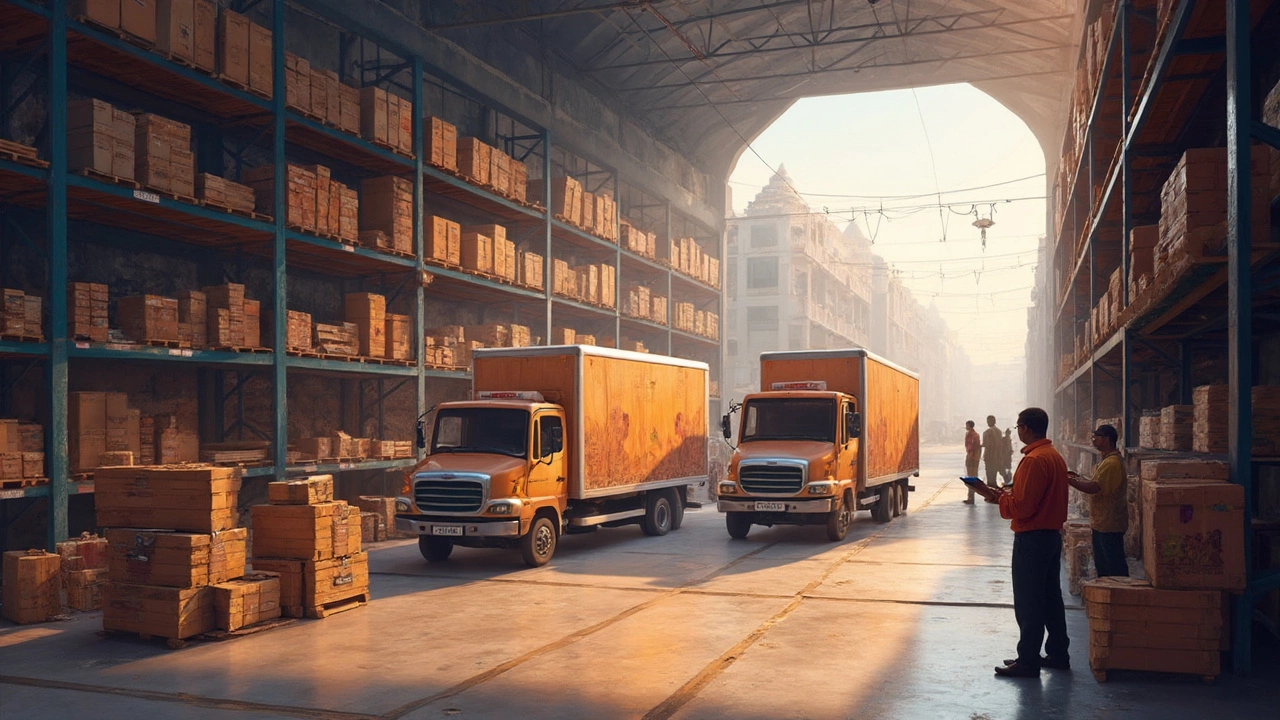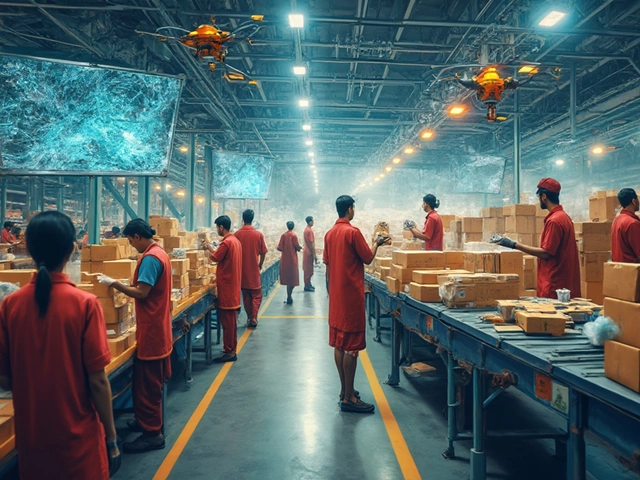Ever ordered something online and marveled at how fast it showed up at your doorstep? That's logistics in action. These days, logistics isn’t just about trucks and warehouses; it’s a whole system making sure each item lands exactly where it should, and fast. Logistics in commerce might sound a bit too business-y, but it's pretty essential for our online shopping sprees.
In the world of e-commerce, logistics gets things from point A to B in the smoothest way possible. It’s not just about the travel; it’s about getting products in your hands efficiently and reliably. Imagine ordering a new gadget, and it takes a week longer than you thought—how frustrating, right?
For a business, logistics means everything from keeping stock organized in warehouses to choosing the best delivery methods. And trust me, finding the sweet spot in this system can make a big difference in keeping customers happy. When done right, logistics can be a game-changer, boosting customer satisfaction and keeping the whole operation seamless.
- Understanding E-commerce Logistics
- The Role of Warehousing
- Supply Chain Management Basics
- Technology in Logistics
- Tips for Efficient E-commerce Logistics
Understanding E-commerce Logistics
E-commerce logistics sounds complicated, but it's really just the whole process that makes online shopping possible. Think about all the steps involved from when you click 'buy' to when the package arrives at your door. Each of these steps falls under the logistics umbrella.
At the core, it's about resource management. E-commerce logistics handles everything from stocking warehouses with the right products to shipping them correctly. If a company doesn’t nail this process, we’d all be left wondering where our new shoes wandered off to.
One of the first steps in this process is warehousing. Companies need to figure out where to store all the stuff they sell online. This also means deciding how much to keep on hand, so products don’t run out unexpectedly or pile up. Bad stock management could mean missed sales or huge discount bins.
Once products are stored, the focus shifts to how they get from the warehouse to us. This involves slick planning and sometimes a little tech help. Many businesses use inventory management systems to keep track of what’s where, and tools like route planning software make sure packages take the quickest path from warehouse to doorstep.
Lately, speed has become a huge focus. With companies like Amazon offering crazy-fast shipping, expectations have skyrocketed. Now, even small e-commerce stores need to hustle to keep up. This is where last-mile delivery comes in—it's like the final leg of a relay race, and often the trickiest part. Getting this last step right can make all the difference in how satisfied customers are with the service.
Technology plays a big role here. Retailers use all sorts of smart tech like automated robots in warehouses and drones for deliveries. These gadgets help cut down on time and, of course, costs.
Ever wondered what a winning logistics setup looks like? Prominent e-commerce platforms march to success with this mix of savvy planning, tech innovations, and speedy delivery methods. They turn logistics into a competitive advantage, focusing on reliability and speed.
To put it in numbers, did you know that improving logistics can slash delivery times by over 20%? That’s pretty impressive, right? It’s all about making sure every part of the network is running like a smooth machine.
The Role of Warehousing
When we talk about logistics, warehousing is a big deal. It’s the heart of organizing how stuff gets to you once you hit that 'buy now' button. Warehouses aren’t just massive buildings filled with shelves; they’re the brains of the supply chain where everything is stored, sorted, and shipped out. Think of them as giant puzzle solvers making sure all the pieces—your favorite products—fit just right.
So, how does warehousing work its magic? It involves a few smart strategies, like:
- Storage Optimization: Products aren’t just dumped anywhere. They’re placed in ways that make them quick to pick and pack.
- Inventory Management: This keeps tabs on what’s in stock so they never run out of popular items or pile up on stuff nobody’s buying.
- Technology Use: Warehouses often use advanced software and sometimes even robots to streamline their operations and reduce mistakes.
All this helps businesses save money and boost speed. Faster processing can mean faster shipping, and that’s a win for us impatient shoppers, right?
Here’s a cool stat: warehouses using automation can improve their picking and packing efficiency by about 25%. That’s quite a jump, especially when handling thousands of orders every day.
Ultimately, warehousing is crucial. It ensures that e-commerce businesses deliver what they promise: timely, correct, and hassle-free delivery, making the online shopping experience as smooth as ordering pizza on a Friday night.

Supply Chain Management Basics
Alright, so you know how logistics is the big picture of getting stuff from one place to another? Supply chain management is like its super-focused sibling. Think of it as the behind-the-scenes magic in e-commerce logistics that makes sure everything runs smoothly – from raw materials to the finished product in your hands.
A supply chain isn't just about moving products. It’s more of a network of people, activities, and technology all working together to get that awesome new phone from the factory floor into your eagerly waiting hands. At its core, it’s about making the process cost-effective and efficient.
Let’s break it down a bit more. Here are the main elements that typically make up the supply chain:
- Planning: This is where businesses forecast demand and decide how much to produce, ensuring they aren’t stuck with too much or scrambling for more.
- Sourcing: Finding the right suppliers who can provide the quality and quantity of goods needed at the right time. It’s all about building good relationships here.
- Manufacturing: This step transforms raw materials into finished products. The goal? Keep production speedy but quality high.
- Delivery: Also known as logistics – getting goods to consumers efficiently. This often involves warehousing and last-mile delivery solutions.
- Returns: A smooth return process is crucial for customer satisfaction. It’s all about making sure customers can easily send stuff back.
You know what's interesting? Many businesses are now using tech to keep things on track. Things like RFID tags for tracking inventory and AI for smarter demand forecasting. How cool is that?
Here’s a quick glance at how technology is enhancing supply chain efficiency:
| Technology | Benefit |
|---|---|
| RFID | Improves inventory accuracy |
| AI & Machine Learning | Better demand forecasting |
| Blockchain | Enhanced transparency in transactions |
Understanding the supply chain basics can really set up a business for success. It's all about knowing the essentials and having a strategy to tackle any pitfalls along the way.
Technology in Logistics
Technology, as you can guess, is a massive game-changer in logistics. Just think about how barcodes and scanning systems have made tracking packages easier and way faster. E-commerce businesses rely on tech to keep things running smooth, from order processing to final delivery, making sure stuff gets where it needs to be without a hitch.
One big player here is warehouse automation. Automated systems can stack, sort, and even pick items, cutting down human error and speeding up the process. Imagine robots working alongside humans to make sure every item is ready to roll out on time. Plus, with technologies like IoT (Internet of Things) devices, warehouses can monitor stock levels in real-time, which helps avoid running out of stock or over-ordering. It’s like having eyes on everything, all the time.
Then there's the role of big data. Using vast amounts of data, companies can forecast demand and optimize delivery routes, saving both time and fuel. That means packages can get to customers faster, and who doesn’t love fast shipping?
And we can't skip over the role of artificial intelligence. AI helps in things like predicting delivery times with ridiculous accuracy. It considers traffic patterns, weather conditions, and loads of other data points to make sure delivery promises are kept. There’s also AI in chatbots for customer service, always ready to update you about where your package is.
Here’s a peek at how tech impacts logistics:
- E-commerce platforms use AI to predict delivery times.
- IoT helps in tracking real-time inventory levels.
- Automated warehouses reduce human error in stocking and retrieval.
While tech makes logistics way more efficient, it's also essential for businesses to keep up with the pace of change so they don't fall behind. Embracing new tools and systems can enhance supply chain management and ultimately lead to happy customers. It’s all about making sure each piece of the logistics puzzle fits perfectly, ensuring smooth operations every time.

Tips for Efficient E-commerce Logistics
Running an e-commerce operation smoothly isn’t a walk in the park. Here are some practical tips to nail your e-commerce logistics and keep those deliveries swift and customers smiling.
First off, let’s talk about inventory management. Keeping your inventory in check can save tons of headaches. Use real-time inventory tracking to know exactly what’s flying off the shelves and what’s gathering dust. There are a bunch of software out there that make tracking easier, reducing the risk of selling something you don't have.
Next, choose the right shipping partners. Not all carriers are created equal. Some might be better at quick deliveries, while others offer more cost-effective options. It’s worth researching and maybe even diversifying your options so that you have backup plans when things get busy or go sideways.
Technology is your friend. Automate what you can—order processing, customer notifications, and even reordering supplies. Automation not only speeds things up but also clears up time to focus on growing the business instead of drowning in paperwork.
Consider the location of your warehouses. Locating them closer to your key customer bases might shave a day or two off your delivery times. It’s like setting up camp at a strategic point to reach your destination faster.
Finally, communicate with your customers. Keep them in the loop about where their precious cargo is. Send them real-time updates, and make sure they can reach out easily if there’s a hiccup. Happy customers mean happy business.
Here's a quick breakdown of helpful tools:
- Inventory management software (like Zoho or Cin7) for keeping track of stock levels in real-time.
- Shipping platforms (like ShipStation or EasyShip) to streamline carrier selection and label printing.
- Automated email services that update customers on order status.
By focusing on these areas, businesses can significantly enhance their logistics process, ensuring that when a customer clicks 'buy,' the rest is almost like magic.





